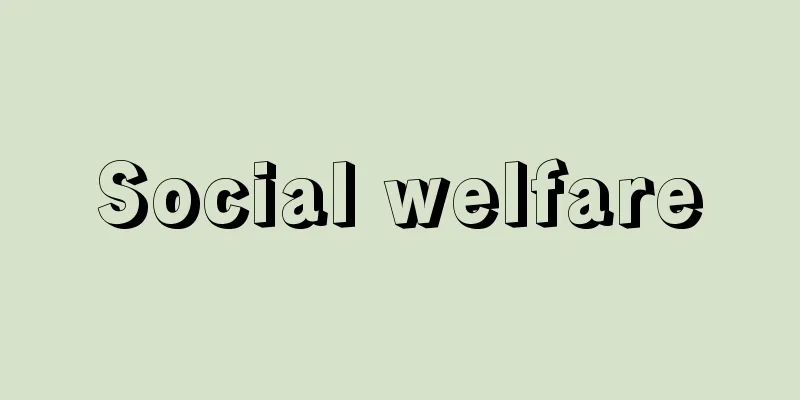Social welfare

|
Social welfare is a multi-faceted concept. According to common terminology in Japan, it is basically used in one of two ways: (1) The state of happiness of members of society. It is something that has not yet been realized in reality and is therefore often considered to be something to be pursued as a goal or ideal. (2) Institutions, policies, practices, etc. aimed at bringing about happiness for members of society. (1) is sometimes called the goal concept, and (2) is sometimes called the substantive concept representing the means or methods. [Yoshiya Soeda and Chizuru Kabumoto] What is Welfare?Katsuo Takenaka (1898-1959), a leading early researcher in social welfare research in Japan, researched the etymology of the German word Wohlfahrt, meaning welfare, in his major work Social Welfare Research (1950), and came to a conclusion similar to that mentioned above. This word began to be used idiomatically around the 16th century, when wohl and fahren were combined. Wohl is an adverbial form of the root of the verb wollen, meaning to wish or desire, and corresponds to the English word well. Fahren is a verb meaning to move from one place to another. As a result of combining these two words, Wohlfahrt came to have the meaning of changing something into a desirable state. Thus, this word has the meaning of the ideal state of human life, as well as the activities and endeavors toward that state. [Yoshiya Soeda and Chizuru Kabumoto] Provisions and interpretations of the Japanese ConstitutionOne of the reasons why the term "social welfare" became widely known and used among the public was its appearance in the articles of the Constitution of Japan, which was enacted in 1946 (Showa 21). Article 25: "All people shall have the right to maintain the minimum standards of wholesome and cultured living. The State shall endeavor to improve and promote social welfare, social security, and public health in all spheres of life." However, even among constitutional scholars, there is another interpretation of social welfare. Naoki Kobayashi (1921-2020) states in his book "Development of Modern Fundamental Rights" (1976) that, within the framework of the Japanese Constitution, Article 25 provides "two practical, narrow and institutional concepts" of social welfare. "In the first paragraph, the so-called right to life that all citizens have, that is, the 'right to live a healthy and cultured minimum standard of living,' can be seen as referring to social welfare in a broad sense (but only a minimum). In the second paragraph, 'social welfare', which is written alongside the words 'social security and public health,' is a narrow concept that is almost synonymous with social work." It is understood that the social work in the quote refers to social welfare work as the current system. [Yoshiya Soeda and Chizuru Kabumoto] Definition by the Social Security System CouncilKobayashi's definition of social welfare, which is the same as the provision on social welfare that appears in the text of the Constitution, is often seen in research on social security and social welfare services. It is likely that Kobayashi's previous definition was modeled after these. One of the pioneering examples of this kind of definition can be found in the recommendation made by the Social Security System Council in 1950. According to this, social security in the narrow sense is divided into four categories: national assistance (public assistance), social insurance, social welfare, and public health and medical care. In the broad sense of social security, pensions and assistance for war victims are added to these, and some housing and employment measures are also listed as related systems. In other words, social welfare is considered to be a subordinate concept of social security, and social welfare is defined as follows: "Social welfare means providing the necessary lifestyle guidance, rehabilitation guidance, and other assistance and training to those who are covered by national assistance, the physically disabled, children, and other people who need assistance and training so that they can become independent and demonstrate their abilities." The year after this definition of social welfare was created, the Social Welfare Services Law (Law No. 45 of 1951) was enacted. It was a somewhat expanded version of what was previously called social work, but was now called social welfare work. The motives behind this name change include the fact that the old image of relief work still lingered in social work, which was disliked, and the fact that the word social welfare was used in the Constitution, and by incorporating this, a more positive image was to be formed. Social welfare work has since often been abbreviated to social welfare or welfare. The definition of social welfare by the Social Security System Council in 1950 was a preparation for the definition of social welfare work that appeared in the following year of 1951 as a legal system. The Social Security System Council, which was located in the former Prime Minister's Office, was abolished with the reorganization of central government ministries and agencies in 2001 (Heisei 13), and its functions were taken over by the Council on Economic and Fiscal Policy of the Cabinet Office and the Social Security Council of the Ministry of Health, Labor and Welfare. [Yoshiya Soeda and Chizuru Kabumoto] Social Welfare LawThe concept of normalization, which emerged in the 1970s (the idea that a society in which people with disabilities and the elderly can live equally together is a normal society), has spread widely mainly through the independent living movement for people with disabilities, and has come to be seen as one of the important principles of social welfare in Japan. It also acts in line with the orientation of social security reform, which aimed to reduce the social security system after the end of the period of high economic growth. In other words, the basic structural reform of social security in the 1980s and 1990s limited the public responsibility in social welfare services to financial subsidies to users, and did not take responsibility for the supply of services. It was assumed that users would be independent and receive social welfare services by their own choice. In 2000, the Social Welfare Services Act was revised and renamed the Social Welfare Act. The significance of the name change is said to be that social welfare, which had been centered on business operators and providers, is reconsidered from a user-centered perspective, and that the relationship between business operators and users is viewed as equal. Whether or not we can realize user-centered social welfare by changing the perspective of social welfare depends on how the meaning of the name change is reflected in systems and practices. How the public and private sectors will accept independence and responsibility and how to strike a balance will be questioned. [Yoshiya Soeda and Chizuru Kabumoto] Western usageIn Western countries, there are two further usages of social welfare as a method or means that are distinct from those mentioned above. In one, the target of social welfare is the entire nation, and all social services related to their lives are social welfare. This usage is often seen in the United Kingdom, and specifically, it means all policies and practices that guarantee the lives of citizens "from the cradle to the grave" in a welfare state, and includes public policies such as labor, education, and housing as social welfare. In the other, it is said that social welfare is helping people to use services related to their lives and solve their own life problems independently. This can be said to be a concept of social welfare that appears at the extreme of the idea of social work technology established in the United States. [Yoshiya Soeda and Chizuru Kabumoto] Global Social WelfareAlthough the above social welfare concepts may or may not have been stated explicitly, they were all considered within the scope of a single national society. In contrast, the conditions are already ripe for us to consider social welfare in world society, global society, and on a human scale. The idea of considering welfare on a global scale was advocated by Myrdal in the 1950s, using the term "welfare world." Since the 1990s, after the end of the Cold War, the issue of ethnicity (people with characteristics or identity as a certain ethnic group) has erupted. Attempts have been made to resolve the coexistence of ethnic minority groups (people who are discriminated against and excluded within a group) and majority groups (the majority of members within a group) through policies. However, the concept of the nation-state remains deeply rooted, and responses to minorities beyond nationality are still in their infancy. [Yoshiya Soeda and Chizuru Kabumoto] Soeda Yoshiya (ed.), Sociology of Social Welfare (1976, Ichiryusha) ▽ Nakamura Yuichi et al. (eds.), Lectures on Social Welfare, 10 volumes (1981-1999, Yuhikaku) ▽ Ichibankase Yasuko and Komatsu Gensuke, Introduction to Social Welfare (1984, Ishiyaku Publishing) ▽ Social Security Research Institute (eds.), Social Welfare Reform Theory I and II (1984, University of Tokyo Press) ▽ Nakamura Yuichi, Introduction to Social Welfare (1991, Seishin Shobo) ▽ Furukawa Takatsugu, Shoji Yoko, and Sadafuji Takehiro, Social Welfare Theory (1993, Yuhikaku) ▽ Miura Fumio, Social Welfare Policy Research, Revised and expanded edition (1995, National Social Welfare Council) ▽ Furukawa Takatsugu, Social Welfare: A Paradigm for the 21st Century - Theory and Policy (1998, Seishin Shobo) ▽ "Ichibankase Yasuko, Takashima Susumu, Takada Shinji, Kyogoku Takanobu eds., "Review and Outlook: Lecture Series: Review of Postwar Social Welfare and Outlook for the 21st Century (1) Review and Outlook" (1999, Domesu Publishing)" "Hoshino Shinya, "The Possibilities of 'Selective Universalism'" (2000, Kaiseisha)" "Iwata Masami (ed.), Iwasaki Shinya eds., "Readings on Social Welfare in Japan, Vol. 1" (2011, Japan Library Center)" [References] | | | | | | | | | | |Source: Shogakukan Encyclopedia Nipponica About Encyclopedia Nipponica Information | Legend |
|
社会福祉は多義的な概念である。日本における一般的な用語法によれば、それは、基本的には次の二つの意味のいずれかで使われている。 (1)社会成員の幸福な状態。それは、現実にはまだ実現していないものであり、したがって、目標や理想として追求するべきものであるとされることが多い。 (2)社会成員の幸福な状態をもたらすための制度、政策、実践など。 (1)を目標概念、(2)を手段、方法を表す実体概念ということもある。 [副田義也・株本千鶴] 福祉とは何か日本の社会福祉研究の初期の代表的研究者竹中勝男(1898―1959)は、主著『社会福祉研究』(1950)において、福祉を意味するドイツ語Wohlfahrtの語源を研究し、先に述べたところとほぼ同じ結論に達している。このことばは、16世紀ごろwohlとfahrenとが結び付いて慣用的に使われ始めたものである。wohlは、願う、望むという意味の動詞wollenの語基が副詞化したもので、英語のwellにあたる。fahrenは、一つの場所から他の場所に移るという意味の動詞である。この二つの単語が結び付いた結果としてのWohlfahrtは、望ましい状態に変えるという内容をもつことになった。そうして、このことばには、人間の生活の理想状態という意味と、その状態に向かう営み、活動という意味とがある。 [副田義也・株本千鶴] 日本国憲法の規定と解釈「社会福祉」ということばが、国民の間に広く知られ、使われるようになったきっかけの一つは、それが1946年(昭和21)に制定された日本国憲法の条文に登場したことであろう。 「第25条 すべて国民は、健康で文化的な最低限度の生活を営む権利を有する。 国は、すべての生活部面について、社会福祉、社会保障及び公衆衛生の向上及び増進に努めなければならない。」 しかし、憲法学者の間でも、この社会福祉について別の解釈もある。小林直樹(なおき)(1921―2020)は『現代基本権の展開』(1976)において、日本の憲法の枠組みのなかでいえば、第25条は、社会福祉の「広狭二つの実用=制度的概念」を与えている、と述べている。「その前段で、すべての国民が有するとされるいわゆる生存権、すなわち『健康で文化的な最低限度の生活を営む権利』は、広義の(但(ただ)しミニマムの)社会福祉を指すとみてよいだろう。その後段で、『社会保障及び公衆衛生』という言葉に並記された『社会福祉』は、社会事業と殆(ほとん)ど同義の狭い概念である」とした。引用文中の社会事業は、現行制度としての社会福祉事業をさすものであろうと解される。 [副田義也・株本千鶴] 社会保障制度審議会による定義小林による、憲法の条文中に現れる社会福祉の規定と同一の社会福祉の定義は、社会保障や社会福祉事業の研究においてしばしばみかけられる。おそらく、小林の先の規定はそれらに倣ったものであろう。この種の定義の先駆例の一つは、社会保障制度審議会が1950年(昭和25)に行った勧告のなかにみられる。それによれば、狭義の社会保障は、国家扶助(公的扶助)、社会保険、社会福祉、公衆衛生・医療の4部門に分かれる。広義の社会保障は、これらに、恩給、戦争犠牲者援護が加えられ、さらに、関連制度として住宅対策および雇用対策の一部があげられている。つまり、社会福祉は社会保障の下位概念ととらえられ、そこでは、社会福祉は次のように定義される。「社会福祉とは、国家扶助の適用を受けている者、身体障害者、児童、その他援護育成を要する者が、自立してその能力を発揮できるよう必要な生活指導、更生補導、その他の援護育成を行なうことをいう」。 この社会福祉の定義がつくられた翌年に社会福祉事業法(昭和26年法律第45号)が制定されている。それは、かつて社会事業とよんだものを、いくらか発展させつつ社会福祉事業とよんだのであった。この名称の変更が行われた際の動機としては、社会事業には救済事業の古いイメージが残存しており、それが嫌われたこと、憲法で社会福祉ということばが使われており、それを取り込むことでより積極的なイメージの形成が図られたこと、などがいわれている。社会福祉事業は、その後、しばしば社会福祉とか福祉と略称されるようになった。社会保障制度審議会の1950年における社会福祉の定義は、法が定める制度としては翌1951年に現れる社会福祉事業の定義を、まえもって準備したかっこうになった。なお、旧総理府に置かれていた社会保障制度審議会は、2001年(平成13)の中央省庁再編に伴い廃止され、その機能は内閣府の経済財政諮問会議および厚生労働省の社会保障審議会に引き継がれた。 [副田義也・株本千鶴] 社会福祉法1970年代に登場したノーマライゼーションの概念(障害者や高齢者を排除するのではなく、ともに平等に暮らせる社会こそがノーマルな社会であるという考え方)は、おもに障害者の自立生活運動を通じて広く普及し、日本でも社会福祉の重要な理念の一つととらえられるようになった。それはまた、高度経済成長期を終えて、社会保障制度の縮小を目的とした社会保障改革の指向性に沿ったものとしても作用している。すなわち、1980年代、1990年代の社会保障基礎構造改革は社会福祉事業における公の責任を利用者への金銭的助成に限定し、サービスの供給については責任はないものとした。そこでは、自己選択によって社会福祉サービスを受給する自立した利用者が想定されている。2000年(平成12)に社会福祉事業法が改正され、社会福祉法と名称が変えられた。名称変更の意味は、事業者・提供者中心であった社会福祉を利用者中心の視点でとらえ直し、事業者と利用者を対等な関係とみることにあるといわれる。社会福祉の観点を転換させることで利用者本位の社会福祉を実現させることができるかどうかは、その名称変更の意味が制度や実践にどう反映されるかに左右される。公と私が自立と責任をどう引き受けていくのか、そのバランスの取り方が問われる。 [副田義也・株本千鶴] 欧米の用法欧米諸国では、方法、手段としての社会福祉について、以上に述べたところと区別されるさらに二つの用法が存在する。その一つは、社会福祉の対象は全国民であり、彼らの生活に関連するすべての社会的サービスが社会福祉であるとする。このような用例はイギリスなどで多くみられるが、具体的には、これは、福祉国家で「揺り籠(かご)から墓場まで」の国民の生活を保障するすべての政策、実践を意味し、労働、教育、住宅などの公共施策を社会福祉に含んでいる。いま一つは、それらの生活に関連するサービスを人々が利用し、自分の生活問題を自主的に解決するのを援助することが社会福祉であるとする。これは、アメリカで成立した社会事業技術の理念を極限化したところに現れる社会福祉概念というべきであろう。 [副田義也・株本千鶴] 地球規模の社会福祉以上の社会福祉は、明言されているか否かの違いはあるにせよ、いずれも、一つの国民社会の範囲で考えられるものであった。これに対して、世界社会、地球社会の社会福祉、人類的規模での社会福祉を考えなければならない条件がすでに熟している。福祉を世界規模で検討する発想は、1950年代にミュルダールが「福祉世界」ということばで主張していた。1990年代以降、冷戦が終結してから噴出してきたのはエスニシティ(ある民族としての特性やアイデンティティをもつ人々)の問題である。マイノリティ(集団のなかで差別・排除の対象となる人々)集団であるエスニシティとマジョリティ(集団のなかでの多数の成員)集団との共存を、政策によって解決する試みがなされるようになってきた。しかし、国民国家の概念は根強く残り、国籍を超えたマイノリティへの対応はいまだ萌芽(ほうが)状態にある。 [副田義也・株本千鶴] 『副田義也編『社会福祉の社会学』(1976・一粒社)』▽『仲村優一他編『講座 社会福祉』全10巻(1981~1999・有斐閣)』▽『一番ケ瀬康子・小松源助著『社会福祉概論』(1984・医歯薬出版)』▽『社会保障研究所編『社会福祉改革論』Ⅰ・Ⅱ(1984・東京大学出版会)』▽『仲村優一著『社会福祉概論』(1991・誠信書房)』▽『古川孝順・庄司洋子・定藤丈弘著『社会福祉論』(1993・有斐閣)』▽『三浦文夫著『社会福祉政策研究』増補改訂(1995・全国社会福祉協議会)』▽『古川孝順編『社会福祉21世紀のパラダイム――理論と政策』(1998・誠信書房)』▽『一番ケ瀬康子・高島進・高田真治・京極高宣編『総括と展望 講座・戦後社会福祉の総括と二一世紀への展望(1)総括と展望』(1999・ドメス出版)』▽『星野信也著『「選別的普遍主義」の可能性』(2000・海声社)』▽『岩田正美監、岩崎晋也編『リーディングス日本の社会福祉 第1巻』(2011・日本図書センター)』 [参照項目] | | | | | | | | | | |出典 小学館 日本大百科全書(ニッポニカ)日本大百科全書(ニッポニカ)について 情報 | 凡例 |
Recommend
Nanjo clan
A powerful local lord in medieval Hoki Province. A...
loi des débouchés
…It is named after the French economist JB Say, w...
edaphology
...A branch of natural science that studies soil....
Omiya Post Town
...The area around Hikawa Shrine is the prefectur...
Kinkei Academy
It was a nationalistic educational organization f...
Socialism - English spelling: socialism
The word socialism first appeared as socialism in...
Apollinarius
[Birth] Around 310 [Died] Bishop of Laodicea aroun...
Pear orchard - Rien
A term referring to the theatrical world, especial...
Stanisław August Poniatowski
1732‐98 The last king of Poland. Reigned 1764-95. ...
jaundice
Concept Jaundice is a condition in which elevated ...
Sejanus, LA (English spelling) SejanusLA
…Roman politician. Also known as Sejanus. His mot...
Infringement of credit
The prevention of the realization of a claim by an...
theRedeless
…He ascended to the throne after his half-brother...
Lamé, G. (English spelling) LameG
… In an isotropic elastic body, Young's modul...
Latin American Literature
[Spanish-American Literature] Latin American lite...




![Azusa River [Village] - Azusa](/upload/images/67cad42d42f88.webp)




